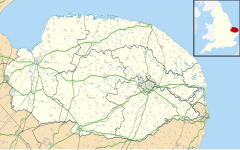Hunworth
| Hunworth | |
|---|---|
 Saint Lawrence parish Church |
|
| Hunworth shown within Norfolk | |
| Population | 101 (parish, 2001 census) |
| OS grid reference | TG0635 |
| • London | 127 miles (204 km) |
| Civil parish | |
| District | |
| Shire county | |
| Region | |
| Country | England |
| Sovereign state | United Kingdom |
| Post town | HOLT |
| Postcode district | NR24 |
| Dialling code | 01263 |
| Police | Norfolk |
| Fire | Norfolk |
| Ambulance | East of England |
| EU Parliament | East of England |
| UK Parliament | |
Hunworth is a village within the civil parish of Stody(where the population is from 2011 included) in the English county of Norfolk. The village is 11.5 miles (18.5 km) east-north-east of the town of Fakenham, 12.6 miles (20.3 km) west-south-west of Cromer and 125 miles (201 km) north-north-east of London. The nearest town is Holt which lies 3.4 miles (5.5 km) north of the village. The nearest railway station is at Sheringham for the Bittern Line which runs between Sheringham, Cromer and Norwich. The nearest airport is Norwich International Airport. The village is situated on the road between Holt and Briston. The parish of Stody, within which Hunworth is located, had, in the 2001 census, a population of 101, being less than 100 at the 2011 Census. For the purposes of local government, the parish falls within the district of North Norfolk.
Hunworth has an entry in the Domesday Book of 1085. In the great book Edgefield is recorded by the name of Hunaworda, Huneworda or Huneworde . The parish is Kings land with main landholders being Alstan, who had been the pre-conquest holder, and his main tenant is said to be Ribald from count Alan and Walter Gifford. There is said to be 4½ Mills. In the Domesday survey fractions were used to indicate that the entry, in this case a Mill, was situated within more than one parish.
On the north east of the village there are the remains of medieval ringworks. These remains are situated on the spur of a hill and overlook the village strategically commanding two crossing points on the river Glaven. The earthworks have a diameter of 95 metres (312 ft) which forms an incomplete ring. The penannular earthwork consist of an inner bank, a ditch and a slight counterscarp bank. At it highest part the bank is 1.5 metres (4.9 ft) above ground level. During excavations carried out in 1965 traces of a possible timber revetment were found which may have been constructed as part of an enclosure. This site is described as a Timber castle and probably Norman. The earthworks are a scheduled monument protected by law.
...
Wikipedia

